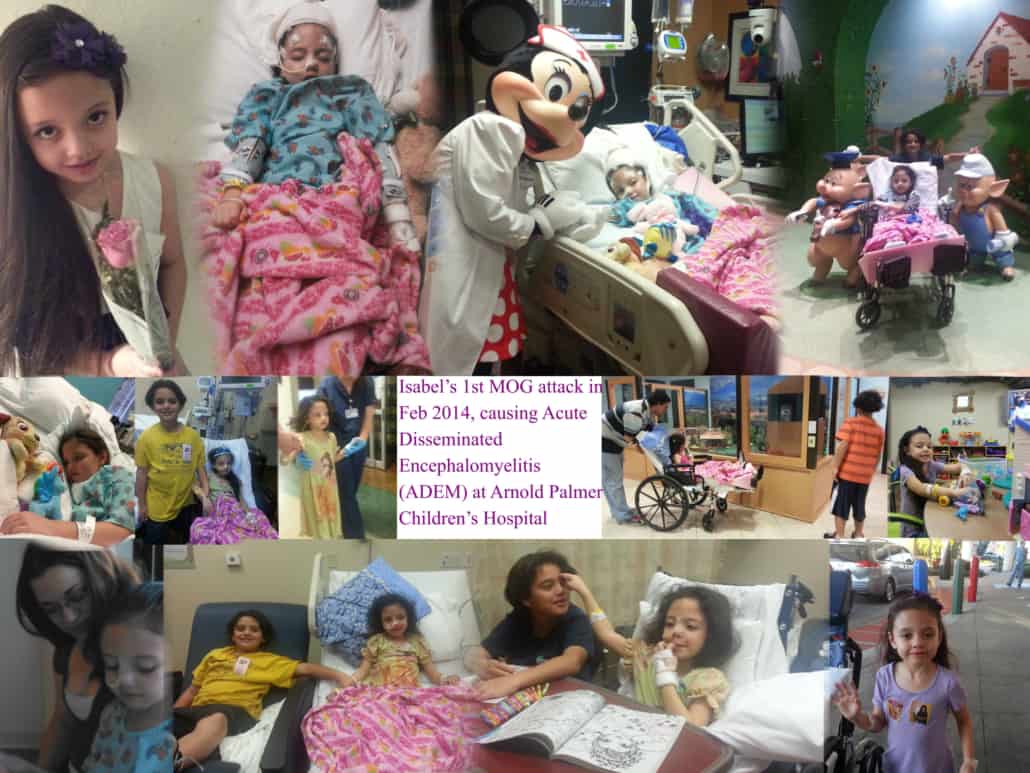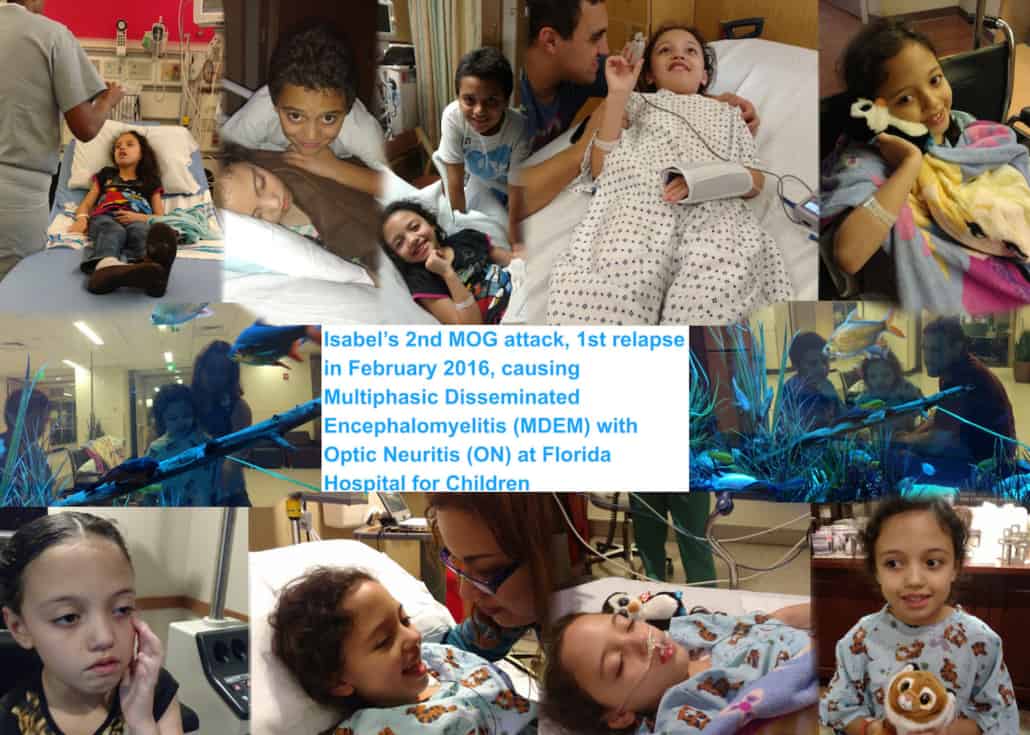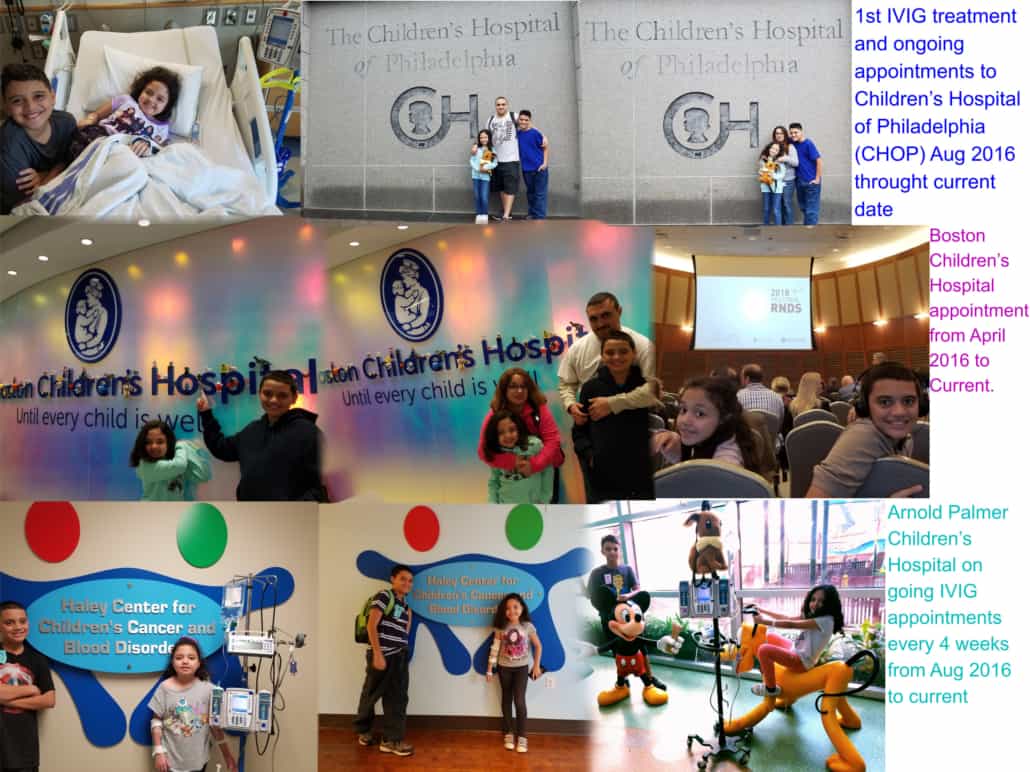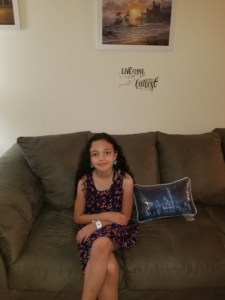A Story of ADEM and a New Illness: MOG Antibody Disease
By Peter Fontanez
In February 2014, at 5 years old, my daughter Isabel was a beautiful, bubbly girl with no health problems. I took her to a Father-Daughter Dance, and she became ill two days later. This was the start of what would amount to three hospital visits and five doctor visits with multiple misdiagnoses. One week after the Father-Daughter Dance, Isabel was admitted for what would turn out to be a misdiagnosed disease. At first, she was having high fever with active vomiting, extreme behavioral changes and her doctors did not know what was going on. They continued to treat her for unrelated illnesses. Even while in the hospital, the doctors there attempted to discharge her, stating that it was only an infection and that she was fine. We told the doctors that it was something neurological and that she was in an altered mental state. They insisted that she was not in an altered mental state and that we did not know what that was. By the next day, she was in the Pediatric Intensive Care Unit (ICU) fighting for her life, paralyzed and unable to speak with absence seizures as well as other neurological problems and altered consciousness.
The new doctors treating her in the ICU were concerned and told us she may not make it through the night as her body was shutting down, and they were concerned her respiratory function may go next. In the ICU the doctors said they would have to rule out meningitis and would have to do a lumbar puncture without sedation due to how far gone she was. They requested that we hold her down since there was no sedation. After the lumbar puncture was negative, they diagnosed her with acute disseminated encephalomyelitis, or ADEM, and at the time, it was believed to be a “one-time illness”. After getting high-dose steroids she was able to come home, and it took over a month to get her walking slightly on her own, out of diapers again, and drinking without a straw. The next 18 to 24 months we had her in therapy to help make almost a full recovery with only a slight cognitive delay being noted.
At the end of January and beginning February of 2016, this supposed “one-time illness” attacked again. For three weeks, we took her to 15 doctor visits with nine different doctors and three hospital visits to be told nothing was wrong and that we were overreacting. At the end of the three weeks, Isabel woke up completely blind in her right eye and losing vision in her left eye. She was also having extreme behavioral changes and severe headaches again. We continued to fight against these doctors, and three weeks after the start of these symptoms and almost two years to the day of the first attack, she had a full relapse of ADEM with optic neuritis (ON).
Doctors then said that we were somewhat right but also wrong in that it was not a relapse but what they thought was multiple sclerosis (MS), a diagnosis they gave without doing any testing. They then tried to treat her with MS drugs, but we refused. We had already done a great deal of our own research, and going on what we learned, we requested a new test for the anti-MOG antibody which they did not do because they did not know what it was and had never heard of it. We knew that the MS treatment would make patients with MOG antibody disease worse and we did not want to chance it without her first being tested for the anti-MOG antibody. The local doctors refused to test her, saying again that we were wrong, that this was MS. After almost being misdiagnosed again in Orlando where we live, we refused to listen to the doctors. We felt what she was having was an even more rare version of her illness called multiphasic ADEM, or MDEM, which is a form of recurrent ADEM primarily caused by anti-MOG. We reached out to multiple hospitals and only Boston Children’s Hospital and Children’s Hospital of Philadelphia (CHOP) contacted us back. Others told us to go to Philadelphia Children’s Hospital. We chose Boston Children’s first, not only because they called us back about a week before Philadelphia Children’s, but also since we were racing against time. Our local doctors were now saying we were withholding care from our daughter since we were not giving her treatment for MS. We needed to do something fast.
Within several weeks, we raced to get an appointment, and in April of 2016, we flew our daughter up to Boston Children’s Hospital to be seen by Dr. Gorman and to get properly diagnosed. The doctor there ran several tests and even tested her for the anti-MOG antibody per our request. He was surprised we even knew about it as the test was still in the research stage, and he told us that most neurologists probably did not even know about this test since it was so new. Boston Children’s tested and ruled out multiple sclerosis and neuromyelitis optica spectrum disorder (NMOSD) at the time. We then went home pending the anti-MOG antibody test which was sent to the Mayo Clinic and weaned her off the steroids over several weeks. She then relapsed almost immediately after ending the steroids in May of 2016 with optic neuritis only this time. In May 2016, after her third relapse, new local doctors again said she had MS due to the ON. It was when we reached back out to Boston Children’s that we were notified that her MOG test came back positive, and she was then put on oral steroids to hold her off until a plan could be made and put into place. Boston Children’s contacted her new local doctors and began working with them and the diagnosis of MS was dropped.
Boston Children’s also asked us to continue with Children’s Hospital of Philadelphia as Dr. Brenda Banwell and her staff were the only notable doctors in the United States at the time who had treated MOG pediatric patients and were familiar with MOG, as they were doing research at the time and were collecting samples. Dr. Gorman also reached out to several doctors familiar with MOG in Germany, the UK, and Australia for additional discussions about MOG as it was still so new, until we could get to Philadelphia. After consultation by Boston Children’s, the decision was made to put my daughter on a treatment plan of Intravenous Immunoglobulin (IVIG) infusions to see if this would help her. IVIG was approved but we were only about two weeks away from an appointment in Philadelphia and held off until we could see Dr. Banwell, since she was familiar with the illness and so she could do the treatment since our local doctors did not know how. We were hoping she would also save a blood sample pre-IVIG for research purposes, which Dr. Banwell was able to save as well. She began treatment in August of 2016 at Children’s Hospital of Philadelphia and has continued with IVIG every 4 weeks since. She continues to receive treatment at the local hospital under the supervision of Philadelphia and Boston. We have been back and forth between Boston and Philadelphia now every three months, alternating between the two hospitals for two years now.
My daughter has had 32 treatments as of this writing. She also had severe complications six times with the IVIG including her first treatment in Philadelphia. Of those six, four of the times ended up with a bad reaction called drug-induced aseptic meningitis, and the doctors up north began discussing possibly switching to chemotherapy-type drugs. We held them off from switching her treatment for personal reasons, and instead she stayed on the IVIG. The IVIG infusion was modified – we slowed it down and added additional medications to help ease her side effects. She is still testing positive for MOG antibody disease and treatments will continue, though they are no longer discussing chemotherapy as she has made such a great recovery with IVIG. In fact, the recovery has been incredible with no major symptoms noted, even recovering fully from all previous paralysis, seizures, major behavioral changes and blindness, to name a few. She continues to have very mild chronic pain symptoms, though they are becoming further apart with each treatment. Now, the pain is lasting only one or two hours instead of days and only happens once a month now if at all. We have also found things that trigger bad days, such as heat intolerance, and have done well to minimize triggers. We believe her progress is because of our current team of doctors, her treatment, and our immediate family unit of mother, father, and brother. We believe this is the key to her recovery.
With our daughter almost passing, and after being told that we did not know what we were talking about regarding her condition, we made a promise to ourselves that we would never be told that again when someone we loved had their life on the line. So, we began to learn everything we could about her MOG and ADEM/ON diagnosis. We share this story to help others who have gone through this as well. We have participated in multiple studies and have shared much of the information we acquired throughout the years to help others. With knowledge of their conditions, people are able to become better advocates for themselves. This year, we were invited to join an advocacy group for MOGAD called the MOG Project as part of their pediatric advocacy. We have also joined the Transverse Myelitis Association as advocates and peer support group leaders for Central Florida. We do this to help further the sharing of information and knowledge as well as to help those who are going through this and similar illnesses to know that they are not alone, and we together as a community will help each other build towards a better future. You are not alone, we see you and we are here together. Do not give up hope and you are stronger than you imagine.









